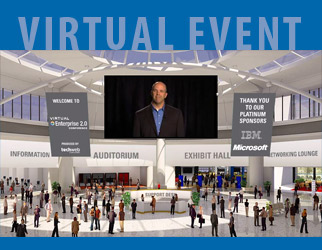 Ah, all the buzz about Google Buzz. Everybody is kicking the tires, experimenting and playfully learning. This is fun – at least for geeks and I can say that the overall experience has been pretty cool. It’s slick, has seen some very good ideas implemented and integrates nicely with my (private) Google account. Some feature requests and some questions still remain, and right – mine are not so much focussed on the consumer experience side but rather on the side of collaboration and knowledge worker’s processes. So no thoughts on mobile usage of Buzz now, nor about usability, complexity or design and only a smallish thought on adoption near the end of this post.
Ah, all the buzz about Google Buzz. Everybody is kicking the tires, experimenting and playfully learning. This is fun – at least for geeks and I can say that the overall experience has been pretty cool. It’s slick, has seen some very good ideas implemented and integrates nicely with my (private) Google account. Some feature requests and some questions still remain, and right – mine are not so much focussed on the consumer experience side but rather on the side of collaboration and knowledge worker’s processes. So no thoughts on mobile usage of Buzz now, nor about usability, complexity or design and only a smallish thought on adoption near the end of this post.
One – I am really waiting for the Buzz to arrive in my Google Apps domain (mail to frogpond adresses is handled by Google Mail, yes, there are a lot reasons for putting mail and apps into the cloud) – and the official announcement wasn’t clear I think:
We also plan to make Google Buzz available to businesses and schools using Google Apps, with added features for sharing within organizations.
Hmm, does this include the standard edition of Apps or is this planned for Premium alone?
Two – let’s applaud Google for relying on open communication standards for its social web endeavours – it’s playing, integrating and – as Chris Messina writes here – leveraging the fabric of the open web. Of course this is helping Google but it’s also helping us, and it’s a wildly disruptive move too (hey, everything that uses Pubsubhubbub is a friend of mine …).
Three – Right, Buzz both validates and marginalizes Friendfeed (I so dig the tag line “FriendFeed Reborn. On Growth Hormone” at Techcrunch). Indeed, the idea of an aggregated life-workstream was just too good to go unsatisfied – and I am now waiting for rooms and/or persistent searches to find their ways into Buzz.
Knowledge workers they need to arrange their groups and channels of communication, finding information from sources that are contextually relevant (and then act upon them, sometimes this may just mean more information filtering, analysis and refining et al.). All in all the knowledge workers workplace can need some more nifty tools that improve productivity – and yes, this is a big topic in Vulcan too everywhere.
Four – Commencing on the context topic of three, what Buzz already has done for me is a boosting of the volume (and so far the usefulness) of Google Reader recommendations. I really like the pre-filtered stuff that gets channeled to me through my social network (and I hope they enjoy the stuff I am recommending and bookmarking on a daily basis).
And now there’s more of it – and it’s easy to “buzzify content” that may start a discussion on Buzz. So I guess we need some more Backtype wizardry to include the Buzz discourse on blogs. That said – we’re still missing threaded conversation, individual favoriting of comments et al. in Buzz. Until that arrives I would rather have the conversation and discourse in here, yet I am not sure how this will work out in the end. But yes, I see and I like that Buzz will allow for more finetuning, filtering and finding stuff that interests me.
Let’s assume then that the adoption rolls in the enterprise sphere too? That’s asking for much now (and let’s not forget that these are beta status thougts …). One reason is that Google is not exactly in the position to enter the large enterprises market, even taking into account the considerable amount of consumerization of corporate IT and collaboration instruments. But I am sure that collaboration systems that merge IM, mail, wiki style collaborative editing, content sharing and communication will succeed in the enterprise too.
So yes, I think they can mount the 9x challenge – Susan asked here whether Buzz can overcome Andrew McAfee’s famous test – and I commented that it’s the integration with Google Mail that helps Buzz access a huge initial user base and network, of which:
[…] some may use it at times, even when it’s not 9 times better than the other ways we communicate
From this initial user base I guess it’s a downhill battle …
So yes, and to sum it up – for now Buzz may be immature, but it has lots of promise to change the way people collaborate and communicate.
PS. I know this could as well been a BMID post – as Buzz pondering touches and meanders around the cultures of innovation, the nerve and resilience to pull through with your innovation and ideas (some have fears Google may not), all in all the excitement and the wonders of technology innovation. And it’s relevant from a business model innovation perspective too, I feel a bit so …

 It’s
It’s  Project Vulcan wird so sicher auch auf dem kommenden Lotus JamCamp diskutiert, das
Project Vulcan wird so sicher auch auf dem kommenden Lotus JamCamp diskutiert, das